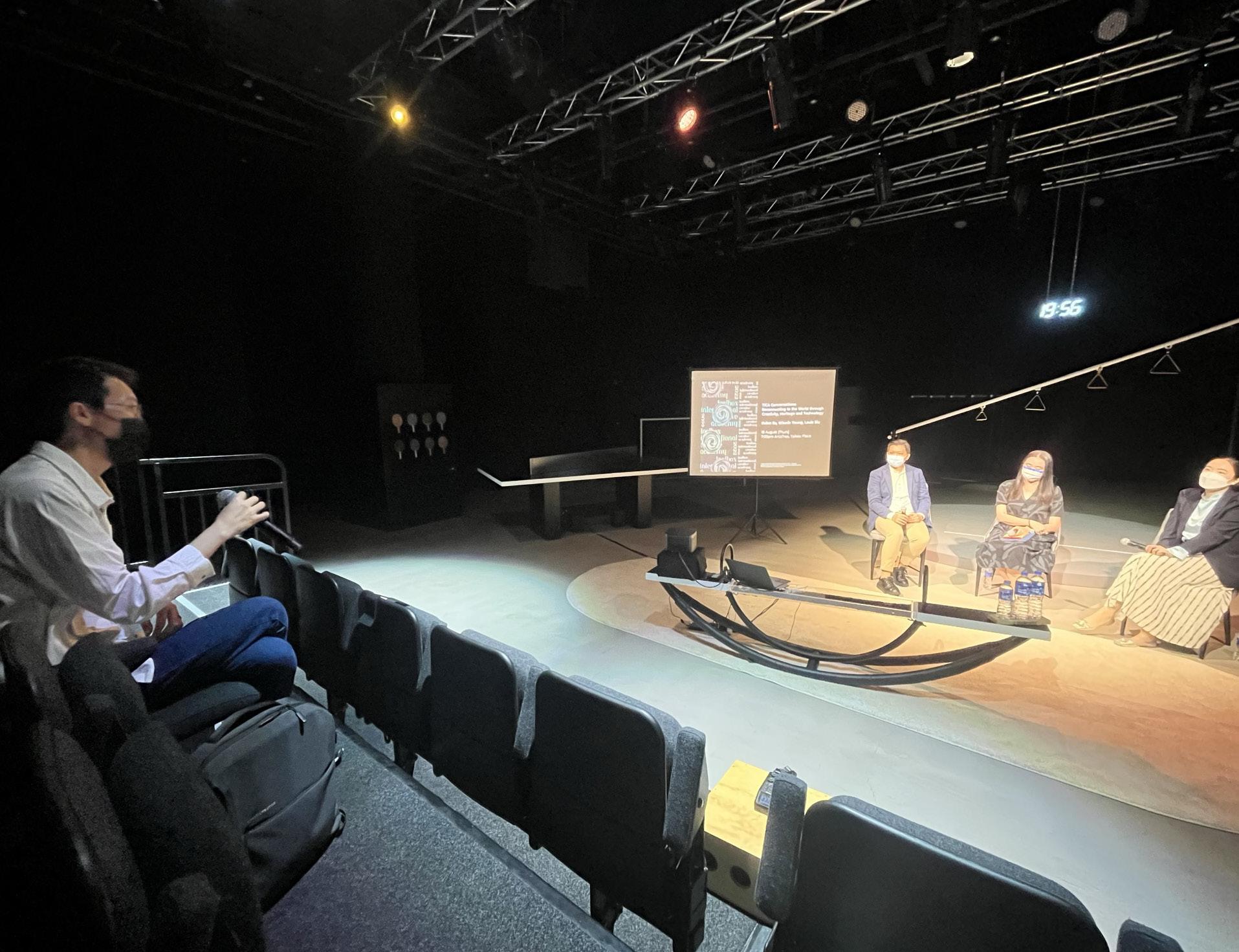
4 minute read
共襄音樂會工作坊 TICA Performance
敲擊樂二重奏 Moitié 放映演奏會 TICA Salon: Percussion Duo Moitié Screening Récital
Aug 14 19:30 ArtisTree
Advertisement
維尼奧 Alejandro Viñao (b. 1951) 律動之書(馬林巴版本) Book of Grooves for two Marimbas (2011) Eunhye Kim, June Hahn - Marimba
Steve Reich (b. 1936) 四重奏 Quartet (2014) Eunhye Kim, June Hahn - Vibraphone Youngwoo Lee, Yukyeong Ji - Piano
維尼奧 Alejandro Viñao (b. 1951) 壓力與流動 Stress & Flow for percussion quartet & electronics (2019) Eunjune Kim, Eunhye Kim, Hyeji Bak, June Hahn – Percussion
重複的節拍、序列所組成的東西,就 是一般理解中樂曲的「律動」(Groove) 或「感覺」(Feel)。透過重複的拍子, 令聽眾想要搖擺、跳舞、踏地;在大 部分音樂中,這動感都必須依靠節拍 存在;換句話説, groove就是被「鎖死」 在節奏中了。若想要「解放」groove, 就恐怕威脅其存在,這恰恰就是本作 品的嘗試。
作品開端,聽眾可以清晰地隨着節 奏搖擺,就是呈現groove最常見的 狀態——被鎖定在節奏中。但逐漸 地,groove慢慢被「解鎖」了:在節 奏重覆的那一��間改變了。如此一來, groove形態漸生變幻。
這樣的變化有其風險,因為聽眾可能 不想要隨着音樂搖擺了,或許有人會 說,這就沒有groovy的感覺了吧。於 我而言,〈律動之書〉是探索迭變,這 種改變並不是groove的自殺。這是 個冒險的作曲策略,因為我們必須確 保從原始的groove中,創造、或複 製出新的材料,而同時不會破壞令樂 曲得以有groovy感覺的精巧平衡。
成功的作品裏,聽眾應該能夠跟從「解 鎖」的過程,或是感受到由原始的材 料中,產生了新的groove。不像流行 音樂般,〈律動之書〉是個永不回歸本 朔的旅行家。「解鎖」的過程並非一個 循環,而是有發展空間的。然而,當音 樂的素材不停地轉化為新元素時,我 亦想保證聽眾永遠不會停止隨著節奏 「搖擺」,這就是我想要達到的。
維尼奧 The 'groove' or 'feel' of a piece is understood to consist of a pattern or sequence that repeats periodically in such a way as to create in the listener the desire to move, or dance, or to foottap following the repeated rhythm. A groove is therefore a rhythm 'locked' into a pattern of repetition. To 'unlock' a groove would mean -to some extent- to threaten its very existence. This is precisely what happens in this piece.
The grooves are presented at first in their simple 'locked' form, so that the listener may swing unequivocally with the initial grooves. But gradually these grooves are 'unlocked', that is to say, they are subjected to transformations that change the point at which they repeat. In this way the shape of each groove is changed.
This involves a risk because the listener may stop feeling the 'desire to move' with the groove. If this were to happen, one could say that the groove has been 'killed'. My idea in Book of Grooves was to explore changes that would transform each groove without 'killing' it. It is a risky compositional strategy: new grooves must be created or 'cloned' from the original ones without disturbing the delicate balance that makes the music 'groove'.
If the piece is successful the listener should be able to follow the process of 'unlocking' or changing of the original grooves into new ones, and experience this as a voyage of transformation. But unlike what happens with grooves in popular music, in Book of Grooves the voyager never returns to the port of departure. The process is not cyclical but developmental. And yet, while the music material is permanently transforming into something new, I wanted to make sure that the listener would never ceases to 'swing' with a groove. This much I wanted to achieve.
四重奏通常被假定是指弦樂四重奏。 但就我而言,在我的許多作品中,發 揮核心作用的四重奏都是敲擊樂的兩 架鋼琴和兩架敲擊樂器。The Desert Music, Sextet, Three Movements, The Four Sections, The Cave, Dance Patterns, Three Tales, You Are (Variations), Variations for Vibes, Pianos and Strings, Daniel Variations, Double Sextet, 和Radio Rewrite中,同一樣的組合,以加 碼的認識呈現:有更多的鋼琴、更多 的顛音琴。在本篇四重奏中,只有這 一組:兩個顫音琴和兩個鋼琴。
這首樂曲是我創作中最複雜的作品之 一。音調(Key)經常改變、中斷連續 的部分,用以暫停或加入新素材。雖 然這些部分並不過分困難,但它需要 高水平的合奏技巧。以「快、慢、快」 的形式,不間斷地彈奏,這亦是種源 遠流長的曲式。而緩慢的樂章部分, 則引入了我較少用的和聲。
史提夫·萊許
壓力與流動
壓力與流動、明與暗、光與影全都能 形容本曲中的對比。不同的節奏效果, 造就了本曲的特點:鮮明的對比與並 列。透過利用電子元素,亦創造了新 的聲音世界。
維尼奧 Quartet, when mentioned in the context of concert music, is generally assumed to mean string quartet. In my case, the quartet that has played a central role in many of my pieces (besides the string quartet) is that of two pianos and two percussion. It appears like that or in expanded form with more pianos or more percussion in The Desert Music, Sextet, Three Movements, The Four Sections, The Cave, Dance Patterns, Three Tales, You Are (Variations), Variations for Vibes, Pianos and Strings, Daniel Variations, Double Sextet, and Radio Rewrite. In Quartet, there is just th is is group alone: two vibes and two pianos.
The piece is one of the more complex I have composed. It frequently changes key and often breaks off continuity to pause or take up new material. Though the parts are not unduly difficult, it calls for a high level of ensemble virtuosity. The form is one familiar throughout history: fast, slow, fast, played without pause. The slow movement introduces harmonies not usually found in my music.
Written By Steve Reich
Stress and flow
Stress and flow, bright and dark and light and shadow are all description of the juxtapositions and contrasts that characterize this work and are arrived at through various rhythmic processes and the use of electronic means to produce new sound worlds. These sound worlds are not meaningful in themselves but work as an extension of the sound of the mallet instruments featured in the piece.
維尼奧曾獲得許多國際獎項和獎項,包括“Golden Nica” Prix Ars Electronica(1992 年)、 聯合國教科文組織世界國際作曲家交流會議上的一等獎(1984 年)等等。 維尼奧的音樂 特色,是透過節奏來建構出大規模的創作,以及通過節奏而不是和聲來發展的旋律寫作。 這與許多非歐洲的音樂不謀而合。
Viñao has received a number of international prizes and awards including the 'Golden Nica' Prix Ars Electronica (1992), 1st Prize at The International Rostrum at the Unesco World Music Council (1984) and many others. Alejandro Viñao's music is characterised by the use of pulsed rhythmic structures to create large scale form, and by a melodic writing which -as in the case of much non-European music- develops through rhythm rather than harmony.
史提夫·萊許 Steve Reich
史提夫.萊許(Steve Reich)為當代作曲大師,與另外幾位作曲家 La Monte Young, Terry Riley, and Philip Glass一樣,其樂風同樣被歸納為極簡主義(minimalism),其作品深 深吸引前衛音樂圈、劇場、舞蹈界朋友的眼光。 史提夫.萊許具有樂壇宗師的地位,其 中Plastic Haircut原聲帶寫於一九六三年,是個短的磁帶拼貼作品,利用磁帶循環創造 了相位語法(phasing patterns),以及一九七○年為四架電風琴所寫的《四部風琴》Four Organs有著重複、緩慢的和諧節奏,以及卡農等顯著極簡主義曲風特色,奠下了萊許作曲 大師的基石。八○年代人在美國的萊許,作品顯露出一種黑暗性格,其中最具代表的就是 一九八八年採用知名猶太主題、為絃樂四重奏與磁帶所寫的《不同的火車》Different Trains。 史提夫.萊許受以下這些媒體讚許與獎座加持,《英國衛報》:「少數被認為改變了 音樂史方向的活著的作曲家」;音樂評論者Kyle Gann:「被敬愛且受到廣大喝采, 美國當代最偉大的作曲家」。
Steve Reich is an American composer who, along with La Monte Young, Terry Riley, and Philip Glass, pioneered minimal music in the mid to late 1960s. Reich's style of composition influenced many composers and groups. His innovations include using tape loops to create phasing patterns (for example, his early compositions It's Gonna Rain and Come Out), and the use of simple, audible processes to explore musical concepts (for instance, Pendulum Music and Four Organs). These compositions, marked by their use of repetitive figures, slow harmonic rhythm and canons, have significantly influenced contemporary music, especially in the US. Reich's work took on a darker character in the 1980s with the introduction of historical themes as well as themes from his Jewish heritage, notably Different Trains.





